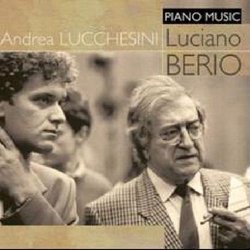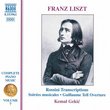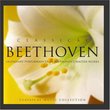Rewarding Modern Piano Music
Paul Turner | 04/09/2008
(5 out of 5 stars)
"Somewhere between Messiaen and Stockhausen was my first reaction on listening to Berio's piano sonata. I thought the endless B flats that chime through the piece were going to drive me nuts, but halfway through the 20-minute piece there is a spectacular explosion of activity that is thrilling. Throughout, the ear is drawn into the extraordinary soundworld, even when the music is, on first acquaintance, rather dry. Zillions of fast repeated notes give several passages a feel of genuine motion and purpose - and the harmony in these exhilarating toccatas as well as the central explosion of chords (a veritable onslaught of light and dark hurled across the canvas) is fascinatingly ambiguous. I feared the music (my first reacquaintance with Berio for half a lifetime) might lack humanity, but I think it will reward repeated listening and will feel composed by a person rather than a system.
On a second hearing of this late work (written 2000-01, two years before the composer's death) I had no trouble with the repeated B flats (which inevitably recall Le gibet from Ravel's Gaspard). When they are superseded by very rapid repeated notes, you wonder (as we are at the piano) if the ghost of Prokofiev has walked across the stage, but to my ears these nightmarish scurryings have stepped out of the pages of Lutoslawski's Concerto for Orchestra, where they dash about the string section. Then (back to the Berio) that eruption of block chords like a musical equivalent of Pollack, then toccata-like passages that propel the action forward to fast chords reminiscent of Messiaen. These ideas alternate with periods of stillness before the reappearance of the tolling B flat. Many chords are almost consonant, many threads of notes almost melodies (though, make no mistake, like all Berio, this is very modern-sounding music!).
Verdict: A deeply rewarding and very strong piece of abstract music (no narrative element, unlike the piano sequenza, also on this disc). Fully worthy of the title Sonata. And the rest of the disc - all marvellously played and beautifully recorded - is equally enjoyable. The notes, including a reminiscence by the pianist of the composer, round off a must for anyone interested in modern piano music."
Not Berio's real voice
scarecrow | Chicago, Illinois United States | 06/10/2008
(5 out of 5 stars)
"Berio openly admitted many years ago that the piano confused him in creativity, also the impending cascades of innovations surrounding him as the various Stockhausen "Piano Pieces", the three Boulez "Sonatas", and Cage's "Music of Changes", all music Berio had experienced in concerts. So he began with the "Five Pieces",an early Fifties piece; very clean threadbare music with Berio's penchant for atonal lyricism,haunting kinds of expressions here similar to Dallapiccola sort of hovers in the back, like a sword not of Damocles hanging but perhaps an icon more gentle and nurturing. These "5 pieces" in retrospect still have a sustenance and longevity, even if a modest contribution to the growing avant-garde literature, Certainly more than the incidental dedications "Erdenklavier" dedicated to academics.
The series of "Sequenzas" are then incredible places for the post-modern voice, each devoted to particular cognitive problem(s), structure, timbre, texture and gesture. The piano "sequenza" utilizes two ideas the sustained timbre and the linearity filigree faster, again Berio's music is always reducible to tropes of expression, of fixed timbral structures, shapes and his real voice resides with the human voice,we find impressive creations there "Epiphanie", and those budding ventures with electronics with Cathy Berberian.
Berio kind of mimics himself in utilizing the piano solo center stage in his opera,"In Re Ascolto" where the piano merely (in resignation) accompanies the festivities . . . the 'Sonata'has its own charm and seems to lean into academia,without any new visions, or new contexts which we are far from "at the end of fruitfull lands" as Finnissy, Sciarrino, Rihm, Murail, Dillon,Skempton have revelaed; again a trace of resignation seems in the air rather than a positive development of a viable piano language. I think Berio thought the piano timbre far too limited for his own voice.
"




